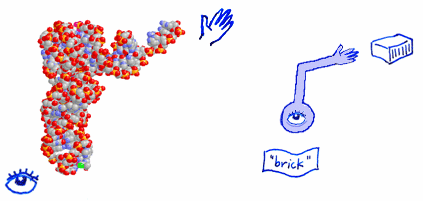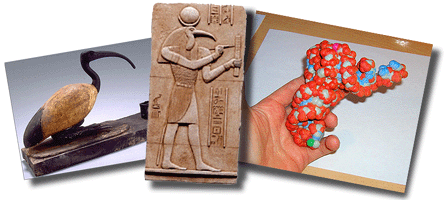Your mother didn’t make you. Who did?
Your mother gave you a warm room and plenty of food. Who made you?
It’s a tricky question. To speak of making implies two things: the thing being made and the one who makes it. Birds make nests. Bees make hives. Carpenters make houses. But mothers don’t make babies. Mothers shelter the construction of babies. You had to make yourself.

From a single cell, you self-assembled, growing exactly as a sprout grows in a greenhouse. One cell became two, two became four, each cell dividing in its turn. The cells grew in precise patterns, ultimately forming bones, sinew, blood, you. Of course, to say you made yourself is not by itself a satisfying answer; you have no idea how you managed it, being very young at the time. So how did the lonely cell you once were become the ten trillion cell colony you are now? The puzzle of biological self-assembly can be reduced to that equally puzzling first step: how does one cell become two? How does a tiny particle suspended in saltwater thrive and beget?
We can think of what happens in our bodies in terms of organs working together: hearts pump, kidneys filter, livers do this and that. It’s easy to picture these organs as sentient entities, businessmen on the phone, talking and coordinating their diverse efforts. But when you get down to the level of the molecules that make up one cell, it becomes harder to keep up this anthropomorphic pretense. Who’s talking and who’s listening? Does a molecule have plans? And if it doesn’t, if there is no planning sentient entity directing the show, then what is?
There are two great mysteries to life: how it began and how it keeps going. The first of these is likely to puzzle us for some time to come, since it happened in the remote past and left few traces. Like an alchemical recipe for gold that requires gold as an ingredient, life as we know it requires life as a starting point. Every living cell we can observe came from some pre-existing cell. But the other great mystery, how life keeps going, how one cell becomes two, is open to our inspection. The broad outlines are already known. To return to the original question: who made you? A bubbling stew of macromolecules built you from the inside out. It’s still unsatisfying as answers go, but we’re learning more with every passing day. A full accounting of the machinery of life is nearer than you might suspect.
The central riddle of cellular construction is the fact that there is no external carpenter to do the work. It must proceed spontaneously, one energetically favorable reaction at a time, according to the laws of chemistry, given whatever supplies happen to be at hand. This is something like saying there are blueprints that can spontaneously turn into houses. How can this be? Molecules bouncing into each other at random sounds like a recipe for chaos. Amid the chaos, there must be hidden order. Some entity is playing the role of carpenter, inspecting the plan and joining the beams. And yet this tiny carpenter must be, after all, simply a molecule (or collection of molecules), not an impish homunculus with a mind of its own. Thus we are picturing something that acts as the bridge between the plans for what is to be built and the building itself, a link between word and flesh. This something is called protein synthesis.
Biochemistry is famously complex, and every statement you can make about it is in some sense a simplification. But the incontestable central engine of life is the general purpose construction process called protein synthesis, wherein the plans packed away in the great libraries of our genes (DNA) are turned into the working molecules (proteins) of the cell. DNA is transformed through a variety of steps into an intermediate message, an order slip for a particular protein, and this order slip (called messenger RNA, or more briefly, mRNA) acts as a template or blueprint for a protein which is then transcribed. Proteins are the worker molecules. Most of a cell’s motion and structure is moderated and directed by proteins. More briefly: protein synthesis made you. But how does it work?
Protein synthesis can be thought of as a translation from the language of DNA to the language of proteins. The messenger RNA order slip that gets sent from the DNA is a message written with an alphabet of four chemical letters called nucleotides. This message is then translated into a protein sequence built entirely from an alphabet of twenty chemical letters called amino acids. So the sequence in mRNA
Adenine-Uracil-Guanine-Adenine-Guanine-Adenine-Guanine-Cytosine-Uracil
becomes the protein sequence
Methionine-Arginine-Alanine
after the protein synthesis apparatus has done its work. This sequence might be, for example, one small part of the protein keratin in your fingernails. A shorthand way of writing this using standard abbreviations looks like this.

But there is a big difference between these two languages. The one on the left is arbitrary, whereas the one on the right is structural. One is word and the other is flesh. This is not a translation in the sense of going from English to Japanese. It’s a translation from a blueprint to a building. The language of proteins is structural in the sense that the words are themselves the bricks, beams, wheels, and motors of the cell. It’s as if the word for brick on the RNA side is matched up with the brick itself on the protein side.

The RNA side is arbitrary because there’s nothing special about the literal word “brick.” What’s special is that it designates the right thing. The word “dog” is no more magically appropriate than its French equivalent “chien,” and as long as they both refer to the same real-world canine, everything is fine. On the other hand if you change the spelling of the protein, the result might no longer function. Instead of a brick, you might be left with a sponge.
But the really interesting thing is the arrow that connects the word “brick” with the actual brick. What exactly is this arrow representing? Semantically, the arrow says that “brick” means brick. Semantics is typically a vague business at best, but this boils down to crystal clear chemistry. This arrow is representing some entity, our little carpenter friend, that can see the word for brick and then grab an actual brick and put it in the right place. The arrow has an eye on one side and a hand on the other.

What should we call the arrow? The arrow is the thing that maps the message in the word to the real world consequence. The arrow is the translator. The arrow is translation.
Normally when we think of an eye moderating the behavior of a hand, there is a brain in between. But we’ve already seen that at the cellular level there are only molecules. There must be a molecule that, through a straightforward energetically favorable process, accurately translates arbitrary messages into specific and useful consequences. That is, a carpenter molecule must exist. It is the physical bridge from thought to deed, which is to say, this carpenter molecule is the chemical incarnation of “meaning.” And not just any meaning. This molecule is the meaning of life. This molecule (actually a family of them) does exist: it’s called transfer ribonucleic acid (tRNA for short). It has a tiny eye on one side that can read the mRNA order slip and a tiny hand on the other that grabs and positions an amino acid. With its eye it reads the plan. With its hand it builds the world. This little carpenter (or rather an uncountable swarm of them) made you and every living thing on Earth. Here it is.

During the Middle Ages and early Renaissance there was much interest in what was called the original language, sometimes called the Adamic language, since presumably it was the language from the time of Adam and Eve until the great confusion of Babel. This original language was considered a historical fact and it was, so the reasoning went, capable of expressing only truth. Whoever learned it would have great power, because the word for something would be identical with that thing’s true nature. To manipulate the name would be to manipulate that which was named. At the same time, perfect harmony would exist between all who conversed in this language. The defining feature of this Adamic language is the perfect relationship between the named object and the object itself. Though no human language has been found with these magical properties, there is a strong mythological imperative to believe in such a thing: at some deep level we know there must somewhere be a special relationship between symbol and reality. Otherwise, how do symbol systems get started? Otherwise, how could we exist?
No one ever taught you the meaning of this particular sentence, yet your brain decodes it without trouble. Somewhere in your brain there must be a link between the symbols that make up this message and the physical consequences that result. “Meaning” is precisely this map from message to consequence. We are familiar with computers interpreting programs, and with people interpreting language, but both of these exist only because life does. Without the language that life is built on, without the synthesis of proteins and the spinning of words into flesh, we would not be here. Messages encoded in our genes constitute the first language. It is not unreasonable to say that “meaning” had no meaning until something existed to interpret it, until a system to process language existed. Before that the universe was just one damn thing after another, sound and fury signifying nothing. Life was the bringer of meaning, and so our creation mythologies are bound up with meaning and creation. As the Gospel of John says: “And the Word was made flesh, and dwelt among us.”

Egyptian mythology gives us a more explicit example. Thoth was the ibis-headed scribe god who invented writing and later gave it to man. Thoth was identified with the ibis because the bird’s curved bill is suggestive of the reed pens that the scribes used. According to a later Egyptian myth, Thoth was also the Creator god. It is instructive that the word-giver should also be the life-giver:
From chaos, Thoth self-created and, existing in chaos, spoke, and his words became covered. Thus began creation. Each word became the thing it signified.
This is the mystical styling of an “Adamic language,” but it is also a reasonable description of the origins of protein synthesis, which is to say it is a reasonable description of the origin of life. This first language self-created and, existing in chaos, spoke. Thus began creation. Each chemical word became the thing it signified, beginning then and continuing to this present moment. Transfer RNA is the pen of Thoth. It is the arrow of meaning, bringing forth the living from the nonliving, busily and daily making the living world around us and within us.






 I have been a fan of David Goodsell’s biology illustrations ever since I came across an article of his in
I have been a fan of David Goodsell’s biology illustrations ever since I came across an article of his in